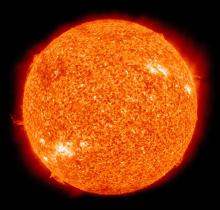Listen to today's episode of StarDate on the web the same day it airs in high-quality streaming audio without any extra ads or announcements. Choose a $8 one-month pass, or listen every day for a year for just $30.
You are here
Last Discovery
In the last couple of decades, astronomers have discovered more than 50 moons of Jupiter. All of them were found in pictures of the giant planet. In fact, the last moon of Jupiter or any other planet discovered without the aid of photography was found 125 years ago tonight.
Edward Emerson Barnard was one of the leading observers of his age. And he was observing the sky with one of the leading tools of the age: a 36-inch telescope at Lick Observatory in California.
Barnard was a junior member of the staff, so he hadn’t been allowed to use the telescope until just a couple of months earlier. And even then, he had it for just one night a week. But he made the most of that time. In August of 1892, for example, he discovered a cloud of gas around a bright “new” star known as a nova. From that, he became the first astronomer to deduce that a nova is a type of stellar explosion.
On the night of September 9th, Barnard saw a small “star” near Jupiter. He thought it was a moon — the first discovered since 1610. The following night, he borrowed the telescope from a colleague to confirm the discovery. The odd little moon was named Amalthea after a character from Greek mythology. It was the last moon discovered just by looking through a telescope.
About that time, Barnard started taking photographs through the telescope. And just weeks after he found Amalthea, he discovered a comet in one of his pictures — the first comet ever discovered with photography.
Script by Damond Benningfield






